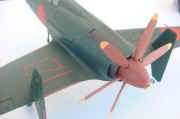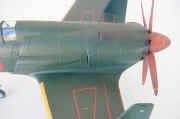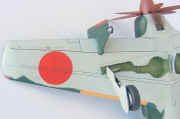Desperate for a high performance interceptor to fight the heavy bombers used by the Allies late in World War II, the Japanese Imperial Navy placed an order with Kyushu Aircraft for a fast and maneuverable fighter capable of mounting large-calibre armament.
The resulting design was radical to say the least. The "canard" configuration (i.e. the elevators are positioned at the front of the airplane) and pusher prop, although used by the Wright brothers in their first aircraft, was unique for fighter aircraft of the time.
The design allowed for more efficient use of space within the aircraft as well as a smaller fuselage design. The lift provided by the front wings allowed for smaller main wings, providing major advantages in reduced aircraft weight and air resistance, points which contributed greatly in the development of a high speed fighter aircraft.
The pusher prop also allowed the main armament (four 30mm cannons, similar to the German Me262) to be grouped in the nose, ensuring greater stability and aiming performance and concentrating the firepower. However, the design came too late in the war for full production. Only two prototypes were completed.
The first prototype of Kyushu ( called Shinden , which means " splendid glow"), flew on the 3rd of August, 1945, just days before the Japanese surrender.
Building the Shinden
|
The kit is the Kyushu J7W1 18-shi Interceptor Fighter "Shinden" from Hasegawa ( No. J6-8805), in 1:48 scale. It is composed of 48 injected parts in light grey color plastic and 3 clear , with no significant ejector marks.
Due to it is a very old model ( molded in 1988), features raised panel lines, as the old-fashioned Monogram´s models. We must remember that the models with engraved panel lines were edited in middle of '90s.
I did not know about this airplane before seeing the kit in my local hobby store. Normally such exotic prototype aircraft are relegated to short-run injection or vacuum-formed manufacturers, and the extra work such kits require would have prevented me from purchasing it.
However, the combination of a unique aircraft and the quality which Hasegawa is known for made this kit irresistible.
This model was constructed in few days, using the instructions from the box, including decals and paint scheme. I only added the seatbelts, using a photoetched from an old model, and radio antenna made of thin stretched sprue.
As well, I did not use filler in this model: it is what I have come to expect from Hasegawa.
|

|

|

|

|
Painting
|
I used enamels for my painting. The simple paint scheme (single dorsal and ventral colors with a hard-edge separation) made airbrushing easy. Note how the upper color wraps around the wing leading edge. Upper and lower colors were Tamiya´s IJN Green ( XF-11)and IJN Sky Gray ( XF 12), respectively, while the cockpit interior was primarily Testor's Interior Green. The props and spinner were painted with Brown X-9.
|

|
I masked and painted the yellow ( Ref. X-4 Tamiya ) wing leading edges ( I did not use the decals ) and propeller tips, putting down a coat of flat white ( Ref. X-2 Tamiya ), followed by the yellow. This needs to be done carefully, so as not to build up too thick a layer of paint, which can be very noticeable when the gloss coat would be applied.
Finishing
|
The gun barrels were painted with Tamiya´s Gunmetal X-10.
Before apliying decals, all model was oversprayed with a gloss coat of Gunze Varnish.
The Hinomarus ( National Japanese insignias) were painted in Red Scarlet color ( Ref. Humbrol 60 ), using a mask.
|

|
I didn't apply the wing-walk decals as a single large decal because of the running lights on the upper surface of the wing. I cut the carrier film from the interior and exterior, and applied them very carefully, using white glue diluted with water. Finally, I oversprayed the entire model with semi-gloss coat, using Gunze varnish again.
As the prototype aircraft flew only three times for a total of 45 minutes flight time, it did not seem appropriate to weather the model. Only a few stains were applied in the exhausts of engine.
Conclusion
Yes, I have been pleased, once again, with an Hasegawa´s model. This is a nice, simple and easy kit to build, ideal for novices. As well, due to its strange appearance, is a nice addition for any collection.
|